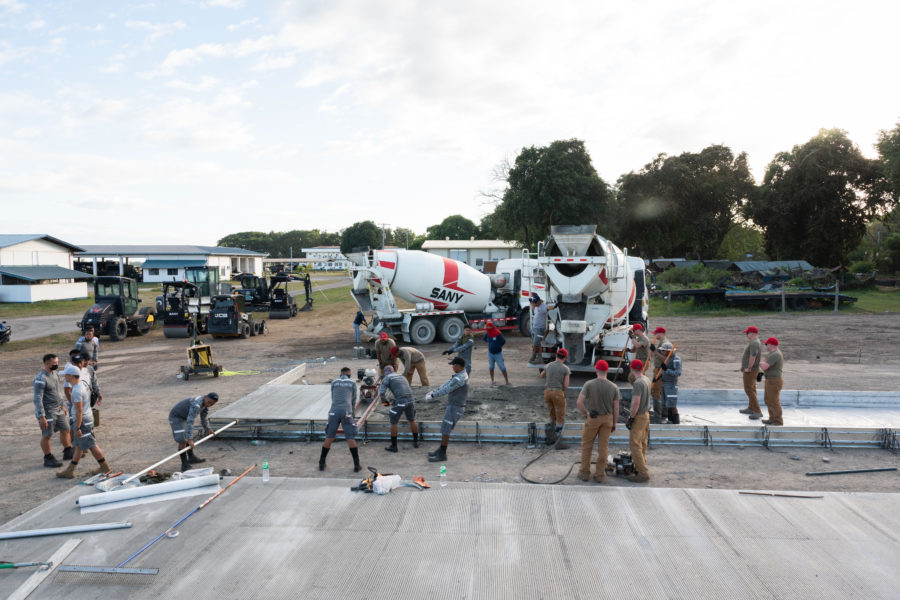From Norway to Australia, and Guam to the United Kingdom, the Air Force wants to invest more money in overseas infrastructure, according to budget documents.
The Air Force is seeking $1.24 billion in appropriations, a 93 percent increase over the prior year, and $872.5 million, a 44 percent jump, in new authorizations for military construction outside the U.S. The plans mark the largest such requests since 2000.
For 2023, the Air Force asked for $637.7 million in appropriations and $605.7 million in authorizations last year.
Pacific
The biggest investment would be at Andersen Air Force Base on the U.S. territory of Guam. Air Force budget documents show it wants $411 million to fund a North Aircraft Parking Ramp, large enough to park up to 14 bombers under normal operational conditions.
Although the Air Force ended its continuous bomber presence at Andersen in 2020, it has continued to rotate heavy bombers to the base on Bomber Task Force missions. BTFs usually include just a few aircraft, so enabling a deployment of 14 would mark a significant expansion.
Without the new apron, Andersen “will be unable to adequately support the bomber aircraft operations during contingencies, significantly impacting readiness and degrading operational capability and may increase the potential for a serious mishap,” the Air Force budget documents state.
Air Force leaders emphasize Agile Combat Employment—dispersing aircraft and Airmen from bigger central bases to numerous remote locations in a “hub-and-spoke” model, and expanding Andersen points would enable it to become a key hub in that scheme.
“This project will also support large force exercises with service components and international partners,” the budget documents state.
But it’s not just Guam that will see extra investment. Pacific Air Forces commander Gen. Kenneth S. Wilsbach noted at the AFA Warfare Symposium in March that making ACE work entails “additional logistics” and infrastructure investment across the entire region.
“There are a significant amount of dollars that are associated with prepositioning at our hubs and spokes, mainly our spokes so that you have sustainment materiel at those places,” Wilsbach said. “So what I’m talking about is fuel parts, support equipment, water, and food mainly. And we’re starting to purchase those and put them out at the spokes.”
The 2024 budget ask includes $78 million for Tinian, another island in the Marianas near Guam, which the Pentagon has tapped for upgrades since returning to the airfield there in 2012. The $78 million would enable the airfield to support cargo and tanker aircraft, with a new jet fuel system, and a new parking apron to accommodate up to a dozen KC-46 or KC-135 tankers.
Another potential “spoke” in the Air Force’s ACE concept could be Basa Air Base in the Philippines, one of a growing number of potential operating bases in the Philippines. The Air Force is asking for $35 million to build a parking apron for USAF and DOD aircraft, separate from those used by the Philippine Air Force.
“Without this apron the United States will not have the facilities needed to train and work alongside the Philippines Air Force to accomplish the bilateral training necessary to build the capability of the Philippine Air Force and modernize the Alliance as a whole,” the budget documents state.
The U.S. Air Force wants to spend some $156.5 million at RAAF Darwin and RAAF Tindal in Australia, to build operations and maintenance support facilities, and a bomber apron at Tindal to accommodate up to six B-52s. Plans to upgrade Tindal’s facilities for up to a half-dozen B-52s were first reported in Australia last fall but not previously confirmed by the U.S. Air Force.
B-52s have previously deployed to RAAF Darwin, but the construction project there is for an expeditionary squadron operations facility that was planned based on design guides from Air Mobility Command.
The Air Force has studied “every single piece of concrete” across the Indo-Pacific in planning for ACE airfields across the region, Wilsbach has said.
Europe
In Europe, Air Force investment plans are more modest, but still expansive. In Norway, the service is seeking $119 million to build storage facilities at Rygge Air Station, south of Oslo, that can hold up to 3 million pounds of munitions and facilities to provide storage and support for the Deployable Air Base Systems kits, sometimes referred to as “bases in a box” that would allow the service to rapidly deploy and operate from more locations.
In the U.K., the Air Force wants to build new facilities at RAF Lakenheath and RAF Fairford to store Rapid Airfield Damage Recovery kits, used to quickly get airfields back into service after an attack. Those RADR facilities would cost a combined $75 million. Also at RAF Lakenheath, the service is planning a new $50 million dormitory for up to 144 beds for a “surety” mission. And at Moron Air Base, Spain, the Air Force seeks to spend $26 million on a new munitions storage facility.
